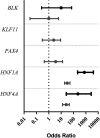Evaluation of Evidence for Pathogenicity Demonstrates That BLK, KLF11, and PAX4 Should Not Be Included in Diagnostic Testing for MODY
- PMID: 35108381
- PMCID: PMC9044126
- DOI: 10.2337/db21-0844
Evaluation of Evidence for Pathogenicity Demonstrates That BLK, KLF11, and PAX4 Should Not Be Included in Diagnostic Testing for MODY
Abstract
Maturity-onset diabetes of the young (MODY) is an autosomal dominant form of monogenic diabetes, reported to be caused by variants in 16 genes. Concern has been raised about whether variants in BLK (MODY11), KLF11 (MODY7), and PAX4 (MODY9) cause MODY. We examined variant-level genetic evidence (cosegregation with diabetes and frequency in population) for published putative pathogenic variants in these genes and used burden testing to test gene-level evidence in a MODY cohort (n = 1,227) compared with a control population (UK Biobank [n = 185,898]). For comparison we analyzed well-established causes of MODY, HNF1A, and HNF4A. The published variants in BLK, KLF11, and PAX4 showed poor cosegregation with diabetes (combined logarithm of the odds [LOD] scores ≤1.2), compared with HNF1A and HNF4A (LOD scores >9), and are all too common to cause MODY (minor allele frequency >4.95 × 10-5). Ultra-rare missense and protein-truncating variants (PTV) were not enriched in a MODY cohort compared with the UK Biobank population (PTV P > 0.05, missense P > 0.1 for all three genes) while HNF1A and HNF4A were enriched (P < 10-6). Findings of sensitivity analyses with different population cohorts supported our results. Variant and gene-level genetic evidence does not support BLK, KLF11, or PAX4 as a cause of MODY. They should not be included in MODY diagnostic genetic testing.
© 2022 by the American Diabetes Association.
Figures

References
-
- Owen KR. Monogenic diabetes in adults: what are the new developments? Curr Opin Genet Dev 2018;50:103–110 - PubMed
-
- Pihoker C, Gilliam LK, Ellard S, et al. .; SEARCH for Diabetes in Youth Study Group . Prevalence, characteristics and clinical diagnosis of maturity onset diabetes of the young due to mutations in HNF1A, HNF4A, and glucokinase: results from the SEARCH for Diabetes in Youth. J Clin Endocrinol Metab 2013;98:4055–4062 - PMC - PubMed
-
- Shields BM, Hicks S, Shepherd MH, Colclough K, Hattersley AT, Ellard S. Maturity-onset diabetes of the young (MODY): how many cases are we missing? Diabetologia 2010;53:2504–2508 - PubMed
Publication types
MeSH terms
Substances
Supplementary concepts
Associated data
Grants and funding
LinkOut - more resources
Full Text Sources
Medical
Molecular Biology Databases
Miscellaneous

